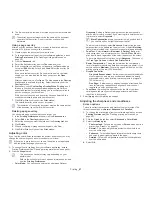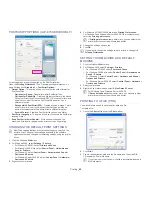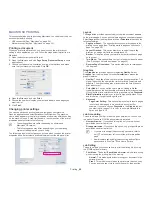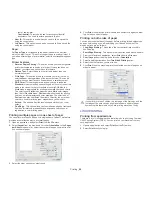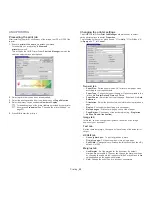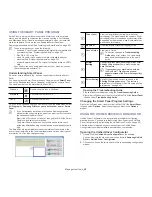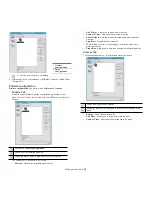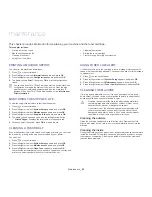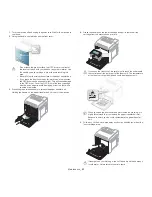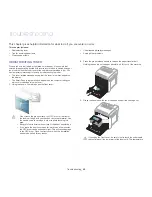
Management tools
_ 58
8.
management tools
This chapter introduces management tools provided to help you make full use of your machine.
This chapter includes:
•
Using SyncThru™ Web Service
•
Using the Smart Panel program
•
Using the Unified Driver Configurator
USING SYNCTHRU™ WEB SERVICE
If you have connected your machine to a network and set up TCP/IP
network parameters correctly, you can manage the machine via SyncThru™
Web Service, an embedded web server. Use SyncThru™ Web Service to:
•
View the machine’s device information and check its current status.
•
Change TCP/IP parameters and set up other network parameters.
•
Change printer preference.
•
Set the email notifications advising of the machine’s status.
•
Get support for using the machine.
To access SyncThru™ Web Service
1.
Access a web browser, such as Internet Explorer, from Windows.
Enter the machine IP address (http://xxx.xxx.xxx.xxx) in the address
field and press the Enter key or click
Go
.
2.
Your machine’s embedded website opens.
Logging into SyncThru™ Web Service
Before configuring options in SyncThru™ Web Service, you need to
log-in as an administrator. You can still use SyncThru™ Web Service
without logging in but you won’t have access to
Settings
tab and
Security
tab.
1.
Click
Login
on the upper left of the SyncThru™ Web Service
website.
A log-in page appears.
2.
Type in the
ID
and
Password
then click
LOGIN
.
If it’s your first time logging into SyncThru™ Web Service, type in the
below default ID and password.
•
ID: admin
•
Password: sec00000
Changing the ID and password
For security reasons we recommand you to change the ID and
password after logging in as a default ID and password.
1.
From the
Security
tab, click
System Security
>
System
Administrator
.
2.
Change the ID and password in the
Web Interface Security
.
3.
Click
Apply
.
SyncThru™ Web Service overview
•
Information tab:
This tab gives you general information about your
machine. You can check things, such as the machine’s status, supplies
status, count information, network information and so on. You can also
print reports such as configuration page and so on.
•
Settings tab:
This tab allows you to set configurations provided by your
machine and network.
•
Security tab:
This tab allows you to set system and network security
information.
•
Maintenance tab:
This tab allows you to maintain your machine by
upgrading firmware and setting contact information for sending email.
You can also connect to Samsung website or download drivers by
selecting the
Link
menu.
E-mail notification setup
You can receive emails about your machine’s status by setting this option.
By setting information such as IP address, host name, e-mail address and
SMTP server information, the machine status (toner cartridge shortage or
machine error) will be sent to a certain person's e-mail automatically. This
option may be used more frequently by a machine administrator.
1.
Start a web browser, such as Internet Explorer, from Windows.
Enter the machine IP address (http://xxx.xxx.xxx.xxx) in the address
field and press the Enter key or click
Go
.
2.
Your machine’s embedded website opens.
3.
From the
Settings
tab, select
Machine Settings
>
E-mail Notification
.
If you haven’t configured outgoing server environment, go to
Settings
>
Network Settings
>
Outgoing Mail Server(SMTP)
to
configure network environment before setting e-mail notification.
4.
Click
Add
button to add e-mail notification user.
Set the recipient name and e-mail address(es) with notification items
you want to receive an alert for.
5.
Click
Apply
.
If the firewall is activated, the e-mail may not be sent successfully. In
that case, contact the a network administrator.
Setting the system administrator information
Set the the system administrator information. This setting is necessary for
using the e-mail notification option.
1.
Start a web browser, such as Internet Explorer, from Windows.
Enter the machine IP address (http://xxx.xxx.xxx.xxx) in the address
field and press the Enter key or click
Go
.
2.
Your machine’s embedded website opens.
3.
From the
Security
tab, select
System Security
>
System
Administrator
4.
Enter the name of the administrator, phone number, location and E-mail
address.
5.
Click
Apply
.




